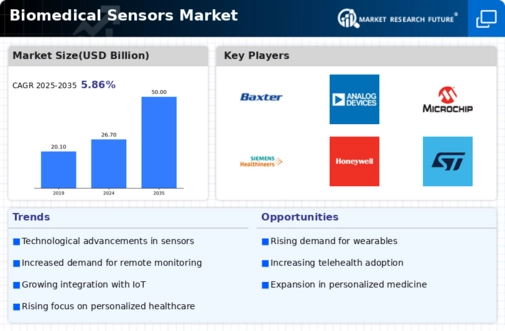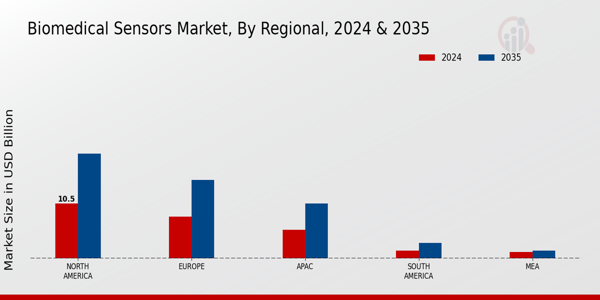Rising Prevalence of Chronic Diseases
The increasing incidence of chronic diseases such as diabetes, cardiovascular disorders, and respiratory ailments is a primary driver of the Biomedical Sensors Market. As healthcare systems strive to manage these conditions effectively, the demand for advanced monitoring solutions rises. For instance, the World Health Organization indicates that chronic diseases account for approximately 70 percent of all deaths worldwide. This trend necessitates the development and deployment of biomedical sensors that can provide real-time data, enabling timely interventions. Consequently, healthcare providers are increasingly investing in these technologies to enhance patient outcomes and reduce healthcare costs. The Biomedical Sensors Market is thus poised for substantial growth as it addresses the urgent need for continuous health monitoring and management of chronic conditions.
Growing Awareness of Preventive Healthcare
The rising awareness of preventive healthcare is significantly impacting the Biomedical Sensors Market. As individuals become more health-conscious, there is an increasing demand for devices that enable proactive health monitoring. This trend is reflected in the growing popularity of wearable sensors that track vital signs and other health metrics. According to recent statistics, the wearable health technology market is expected to surpass 60 billion dollars by 2025, highlighting the potential for biomedical sensors in preventive care. By providing real-time health data, these sensors empower individuals to take charge of their health, leading to early detection of potential health issues. Consequently, the Biomedical Sensors Market is likely to thrive as it aligns with the global shift towards preventive healthcare strategies.
Regulatory Support and Funding Initiatives
Regulatory support and funding initiatives from governments and health organizations are pivotal in propelling the Biomedical Sensors Market. Various governments are increasingly recognizing the importance of biomedical technologies in improving healthcare outcomes and are providing financial incentives for research and development. For instance, funding programs aimed at fostering innovation in medical devices are becoming more prevalent, encouraging companies to invest in the development of advanced biomedical sensors. Additionally, regulatory bodies are streamlining approval processes for new technologies, which facilitates quicker market entry. This supportive environment is likely to stimulate growth in the Biomedical Sensors Market, as more companies are encouraged to innovate and bring new products to market, ultimately benefiting patients and healthcare systems alike.
Increasing Demand for Personalized Medicine
The shift towards personalized medicine is reshaping the Biomedical Sensors Market. As healthcare moves away from a one-size-fits-all approach, there is a growing need for sensors that can provide tailored health data for individual patients. This trend is driven by advancements in genomics and biotechnology, which enable healthcare providers to customize treatment plans based on a patient's unique genetic makeup. The market for personalized medicine is projected to reach over 2 trillion dollars by 2025, indicating a substantial opportunity for biomedical sensors that facilitate personalized monitoring and treatment. By integrating these sensors into healthcare practices, providers can enhance patient engagement and adherence to treatment regimens. Thus, the Biomedical Sensors Market is likely to experience robust growth as it aligns with the evolving paradigm of personalized healthcare.
Technological Advancements in Sensor Technology
Technological innovations in sensor technology are significantly influencing the Biomedical Sensors Market. The advent of miniaturized sensors, improved accuracy, and enhanced connectivity features are transforming the landscape of biomedical monitoring. For example, advancements in microelectromechanical systems (MEMS) have led to the development of highly sensitive and compact sensors that can be integrated into various medical devices. According to recent data, the market for MEMS-based sensors is expected to grow at a compound annual growth rate of over 10 percent in the coming years. These advancements not only improve the functionality of biomedical sensors but also expand their applications across diverse healthcare settings, thereby driving market growth. The Biomedical Sensors Market is likely to benefit from these technological breakthroughs, which enhance the efficiency and effectiveness of patient monitoring.

















Leave a Comment